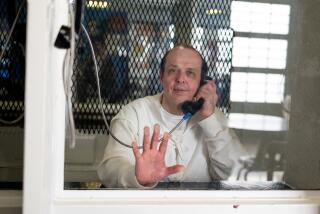Oklahoma’s Lethal Injections Called Fatally Flawed
- Share via
Death by lethal injection faces a significant challenge in federal court today in Oklahoma City, with doctors contending that the state’s method creates an unnecessary risk that a condemned inmate will suffer excruciating pain, in violation of the constitutional prohibition of cruel and unusual punishment.
Nearly 30 years ago, Oklahoma became the first state to develop a procedure for lethal injection -- leading three dozen other states to develop similar methods.
Like challenges to lethal injection in several other states -- including California -- the one in Oklahoma contends that although lethal injection is supposed to be more humane than earlier execution methods, it often masks a painful death.
In sworn statements in the case, anesthesiologists Dr. Mark Heath and Dr. Thomas K. Henthorn say Oklahoma’s method shows state corrections officials have a “fundamental misunderstanding” of the role of the three drugs they use in lethal injections.
All of the suits allege that there is a significant possibility that an inmate does not receive enough of the first drug -- a short-acting barbiturate -- to be sufficiently sedated to not experience pain caused by the second two drugs, a paralytic and potassium chloride, which causes cardiac arrest.
But the Oklahoma suit suggests that the state’s procedure of delivering the drugs through separate intravenous lines placed in each arm has unique faults.
Oklahoma administers 1,200 milligrams of the first drug, sodium thiopental, into the inmate’s left arm.
That is less than any other state, said Heath, an assistant professor of clinical anesthesiology at Columbia University who has also been a defense expert in several other lethal injection cases.
California, for example, has been using 5,000 milligrams, but is proposing to lower it to 1,500.
Oklahoma then administers the second drug -- vecuronium bromide -- through the right arm.
Then it administers potassium chloride in the left arm.
The state then repeats the process, but in reverse: administering potassium chloride in the right arm, sodium thiopental in the left arm, and the paralytic in the right arm. The drugs are dispensed in single doses injected rapidly into a blood vessel, rather than through a continuous infusion of drugs in a slow drip.
Heath said Oklahoma was the only state in the country to use the two-line, two-arm method, which he called medically inadvisable.
Henthorn, chairman of the anesthesiology department at the University of Colorado Medical School, concurred, saying the practice “is medically inappropriate, unnecessary, and creates a severe and unnecessary risk” that department personnel “will not be able to deliver the drugs” properly.
“I cannot imagine any anesthesiologist choosing to produce unconsciousness before a painful procedure in the way described” in the medical examiner’s records of Oklahoma executions, Henthorn said.
“With Oklahoma’s sequence and timing of drugs ... there is better than a 90% chance that a condemned inmate will not have reached a sufficient anesthetic depth” to be certain there wouldn’t be suffering “before reaching deep unconsciousness,” he said. “I can think of no reason to inject these drugs in this way.”
Heath and Henthorn said it was ridiculous for Oklahoma to administer a second dose of the barbiturate after two doses of the heart-stopping drug.
“It is nonsensical to administer any drug, and especially an anesthetic drug to a dead person. The [Oklahoma Department of Corrections] cannot possibly understand the function of the drugs if it believes this order of drug administration is appropriate,” Heath said.
Henthorn agreed, saying “this order of drug administration shows” the corrections department’s “fundamental misunderstanding” of the drugs it uses.
The court challenge was lodged by attorneys for Eric Allen Patton, 48, who is scheduled to be executed Aug. 29 for stabbing Charlene Kauer to death in Oklahoma City during a 1994 burglary.
At a a hearing beginning today, federal public defenders Susan M. Otto and William P. Earley will ask U.S. District Judge Stephen P. Friot, who was appointed by President Bush, to block the execution until there is a full hearing on Oklahoma’s procedures.
The state attorney general’s office attempted to have the suit dismissed, but Friot denied that motion, as well as Oklahoma’s attempt to dismiss another lethal injection challenge, scheduled for a hearing next April.
As of late Monday, Oklahoma had not responded to the issues raised by Heath and Henthorn.
Since 1976, Oklahoma has executed 81 people, third in the nation behind Texas and Virginia.
More to Read
Sign up for Essential California
The most important California stories and recommendations in your inbox every morning.
You may occasionally receive promotional content from the Los Angeles Times.










